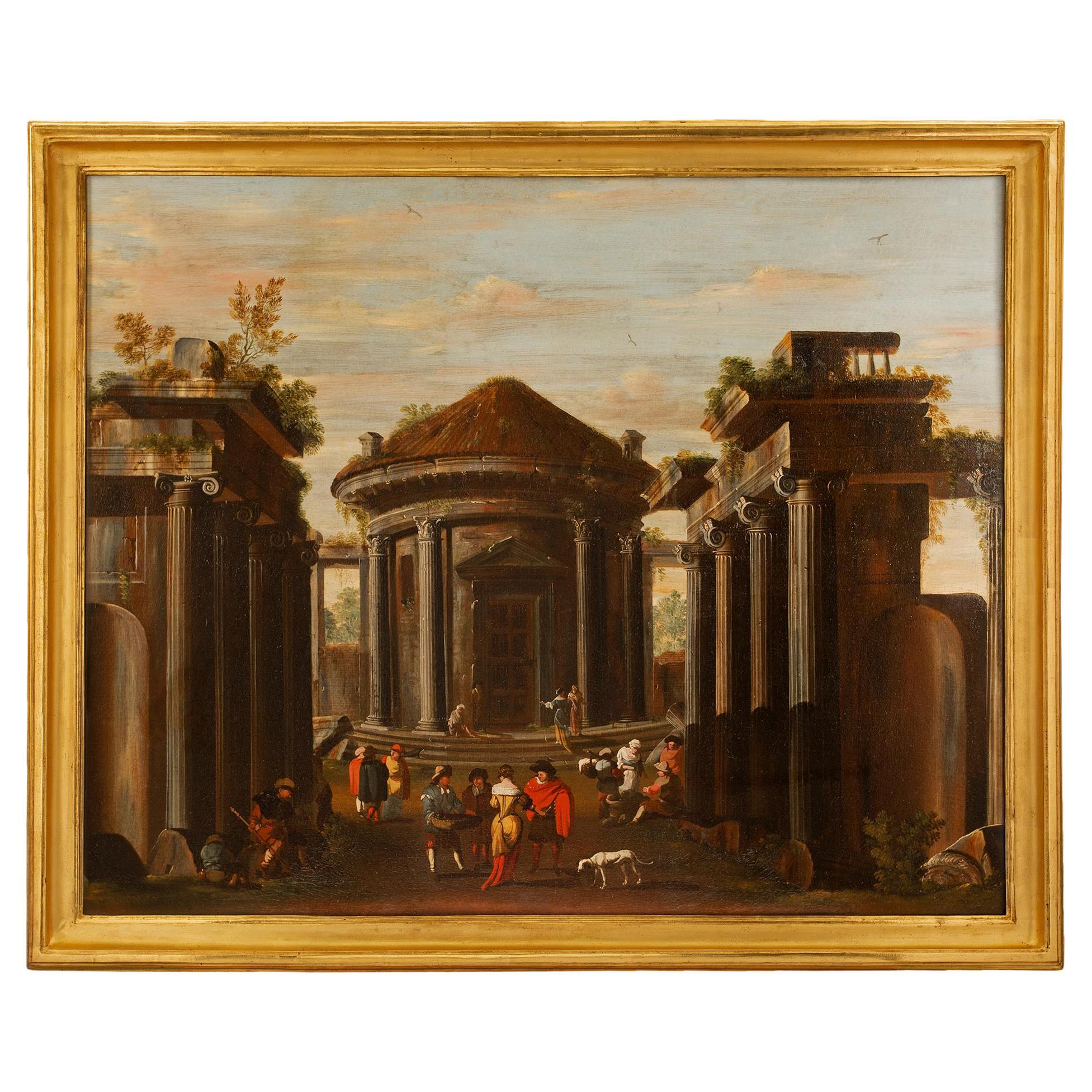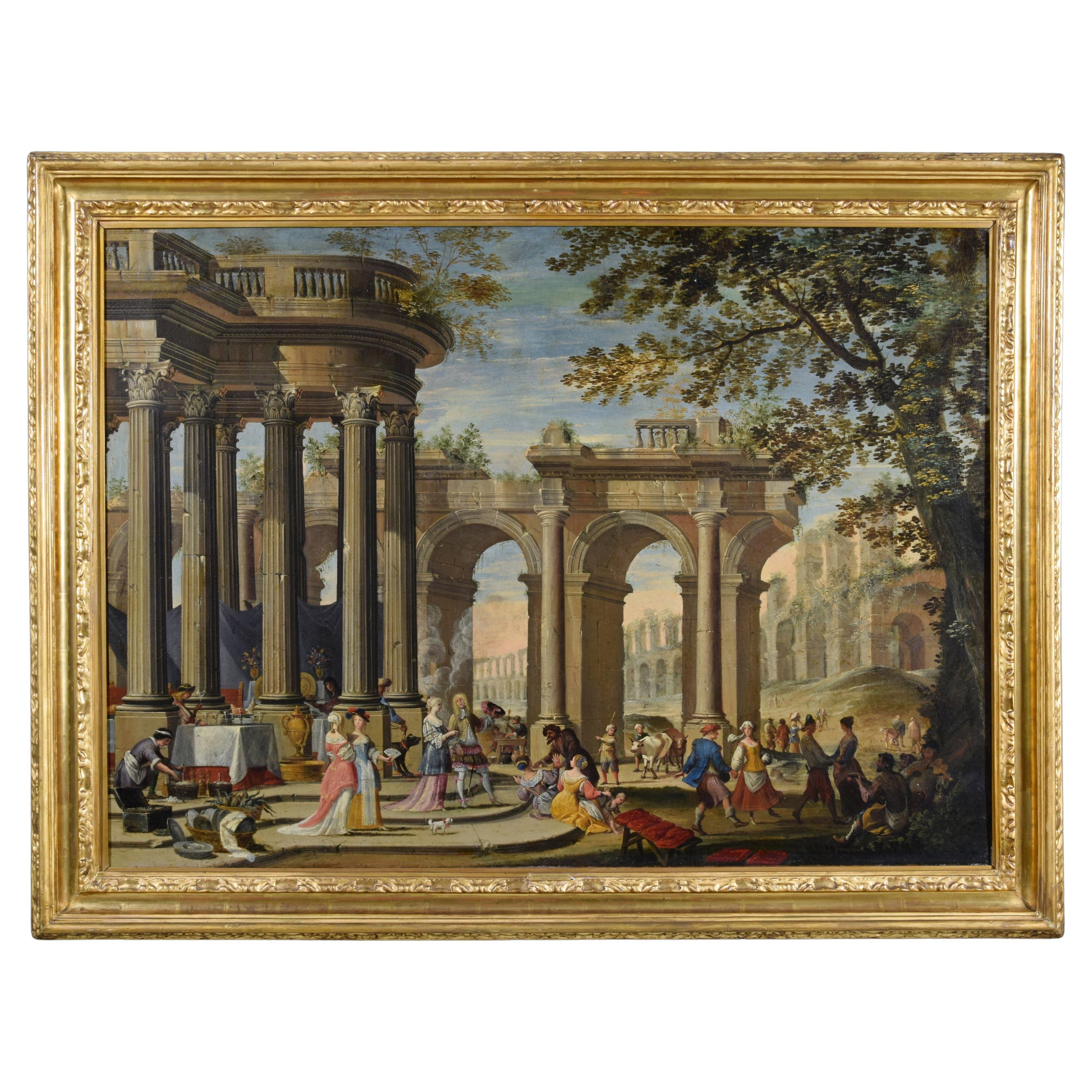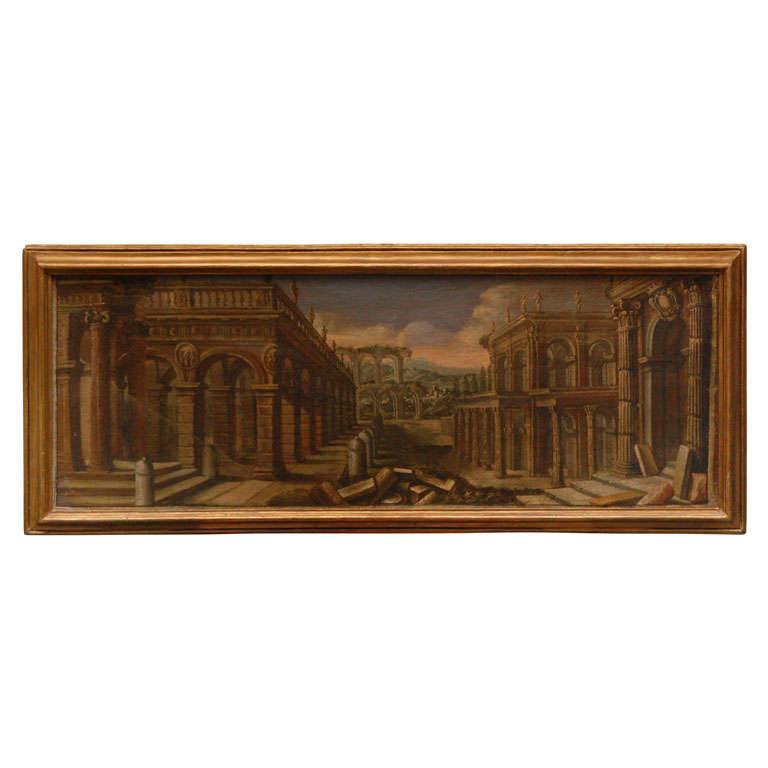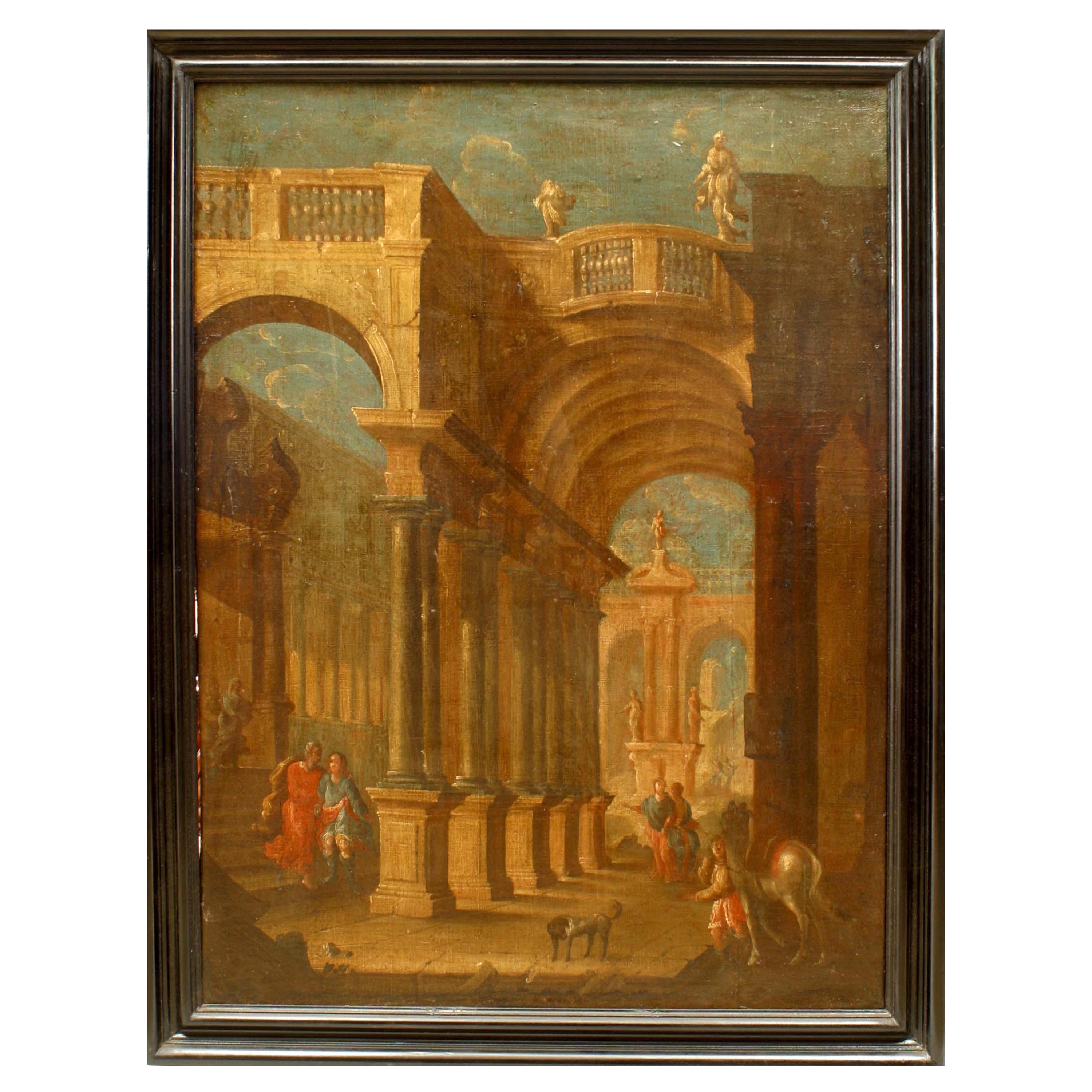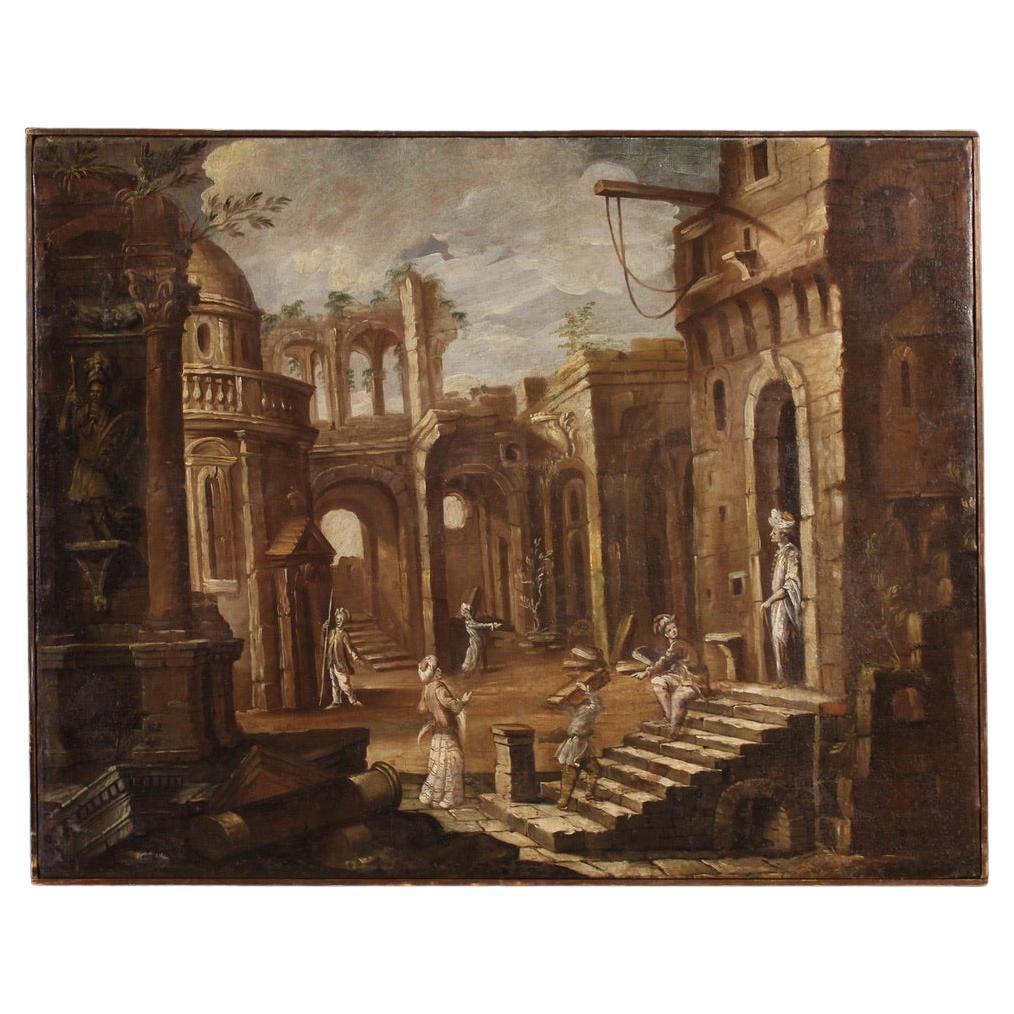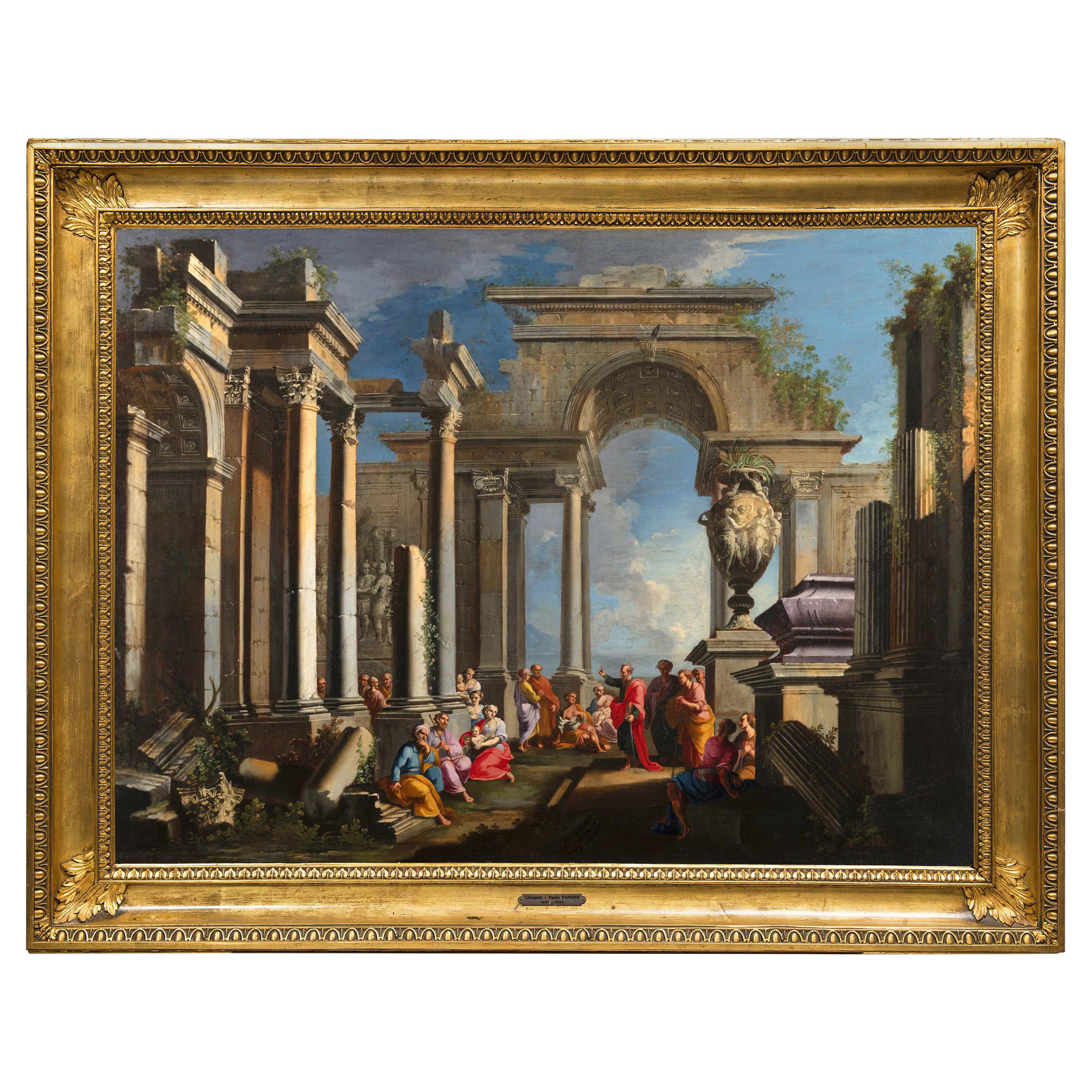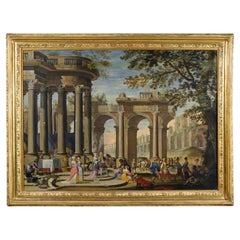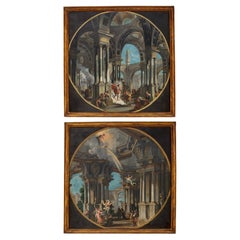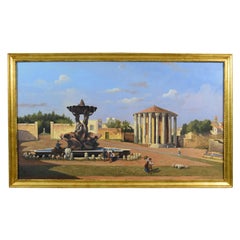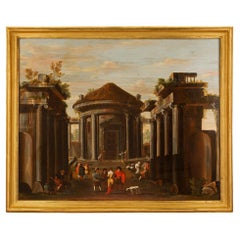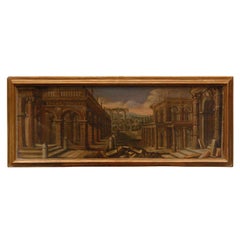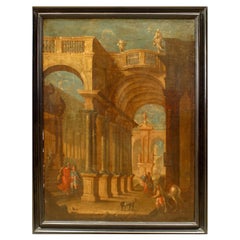Items Similar to 18th Century, Roman Architectural Capriccio Attributed to Francesco Chiarottini
Want more images or videos?
Request additional images or videos from the seller
1 of 16
18th Century, Roman Architectural Capriccio Attributed to Francesco Chiarottini
$34,374.92
£25,744.17
€29,000
CA$48,185.05
A$53,088.70
CHF 27,481.93
MX$639,201.71
NOK 347,987.67
SEK 326,912.40
DKK 220,852.01
About the Item
Francesco Chiarottini (1748-1796)
Roman Architectural Capriccio
Oil on glass, cm 52 x 67 without frame, 63.5 x 79cm with frame
The valuable painting, attributed to the Italian painter Francesco Chiarottini and made of oil on glass, represents an architectural whim, or an architectural fantasy obtained by putting together buildings, archaeological ruins and other architectural elements in imaginary combinations and with unreal but plausible elements. In the work proposed here it is possible to distinguish several ancient monuments existing in Rome. On the right, in the second floor, you can see the Temple of San Pietro in Montorio, while on the opposite side, an arch of triumph, repeated in the distance, seems to be inspired by the Arch of Constantine. Behind the most distant arch is clearly identifiable the Colosseum. In the centre there is an imposing obelisk, also close to the many that stand out in the great Roman squares.
All around many other buildings of classic taste, ruins of Roman temples, a large porphyry tank, a temple with an imperial sarcophagus supported by telamons, staircases and Renaissance buildings are freely inspired by the architecture present in the eternal city. Among the buildings and the ruins several characters animate the composition: they are depicted, some sitting others standing, intent on walking and talking to each other.
The painter uses an unusual and very complex technique, namely painting on glass, which requires unusual artistic skills. The execution must in fact provide as a first draft the highlights and details in the foreground and then proceed in the realization of the parts in the background and then the backgrounds. The artist must therefore paint with an inverse process to the one most commonly used for an oil on canvas. The first works in painting on glass date back to the end of the 17th century; they spread, throughout the eighteenth century, especially in the refined commissions of the Venetian and Neapolitan area. The subjects depicted were often drawn, as reference models, from prints and engravings that could circulate easily.
The work object of this study is clearly inspired by an engraving taken from a work, probably a drawing, by Giuseppe Galli Bibiena.
The print of the engraving appears to mirror the image of our painting. Then when it was realized the engraver where to possess a drawing or a painting superimposable to our work. The same image to which our author therefore looked, similar to one of the many drawings that have survived, of which a significant example is reported.
There is another oil painting in glass, also attributed to Francesco Chiarottini and depicting architectural capriccio with the Monument of the Four Moors in Livorno, the Pantheon and other classical and modern buildings. The measurements of the two works are the same.
It is therefore likely that they were born in pairs or perhaps accompanied by other works.
The second work is also certainly inspired by an etching by Giuseppe Galli Bibiena, entitled Templi e Regia.
Galli da Bibbiena or Bibiena were a family of artists, originally from Bibbiena, now in the province of Arezzo, active in the artistic field for over 150 years, first at the local level and then on a European scale. Its components dealt with painting, architecture and scenography and were in great demand at the courts of half of Europe.
Giuseppe Galli da Bibiena (Parma, January 5, 1696, 1757), second son of Ferdinando Galli da Bibiena, came to equal the fame of his father and became the best known among the Bibbiena of his generation. Giuseppe leaves a copious collection of drawings and engravings of his own works. One of the most important collections of his drawings-studio is published by him in Rome, under the direction of Andrea Pfeffel in 1740-1744, with the title Architectures and Perspectives dedicated to the Majesty of Charles the Sixth Emperor of the Romans by Giuseppe Galli Bibiena, his first theatrical engineer and architect, inventor of the same.
The prints of the engravings of Bibiena had different luck. Among the many artists who welcomed their lesson, drawing inspiration for the layout and the subjects of their works there is Francesco Chiarottini (1748-1796). The constant use of engraving for iconographic proposals and as an aid layout was essential for Chiarottini in his specialization in perspective painting and in the world of scenography.
Francesco Chiarottini was born in Cividale del Friuli, in Italy, on 29 January 1748 to Giobatta and Domenica Dini. In 1760 he moved to Venice to perfect his pictorial vocation. He remained in the lagoon city until 1773 and became a pupil of Guarana, Maggiotto, Fossati and Giandomenico Tiepolo. After a short stay in Udine where he learns with Giuseppe Morelli the fresco technique, for which he will specialize, he goes to Bologna, coming in contact with the scenic ways of Bibbiena, then to Florence, Naples and Rome (1780-1782) where he meets the exponents of neoclassicism, including Antonio Canova.
In 1782 he returned to his native land with a more mature language that linked to the lesson of Tiepolo scenographic stimuli and preliminaries 'rovinistici" on the example of Bibbiena, Panini and Piranesi. It operates in Gorizia, Trieste and Cividale: here it frescoed the staircase and the rooms of the Palazzo Pontotti, today Brosadola. These works reveal a new inventive freedom, enhanced by the domination of spaces and by the perfect harmony of the figures with the environment. In 1786 the Accademia di Belle Arti of Florence appointed him professor honoris causa and the following year he was received at the Accademia Clementina of Bologna. Later, Chiarottini painted theatrical scenes, first in Bologna and then in Rome. He fell ill and began to give the first signs of insanity, which forced him to retire in his Cividale where he died on April 14, 1796, circa 1791.
The noble attempt to reconcile the demands of decorative painting, of 18th century extraction, with the neoclassical creed, nourished by Hellenistic solicitations and archaeological nostalgia, is a common characteristic of his works. In some there is a roving accent closer to the lesson of Panini or Piranesi, while in other works the scenographic aspect and the neoclassical projection, close to the Galli of Bibiena, are more pronounced.
The work object of this study and its pendant, can be attributed to Franceso Chiarottini; as seen, the author uses Bibiena to propose an architectural scenario whose parts were repeatedly investigated by him and proposals.
We apologize for any errors in translation from Italian.
- Dimensions:Height: 31.11 in (79 cm)Width: 25.2 in (64 cm)Depth: 2.37 in (6 cm)
- Style:Neoclassical (Of the Period)
- Materials and Techniques:
- Place of Origin:
- Period:
- Date of Manufacture:Mid-18th Century
- Condition:
- Seller Location:IT
- Reference Number:1stDibs: LU4405218944272
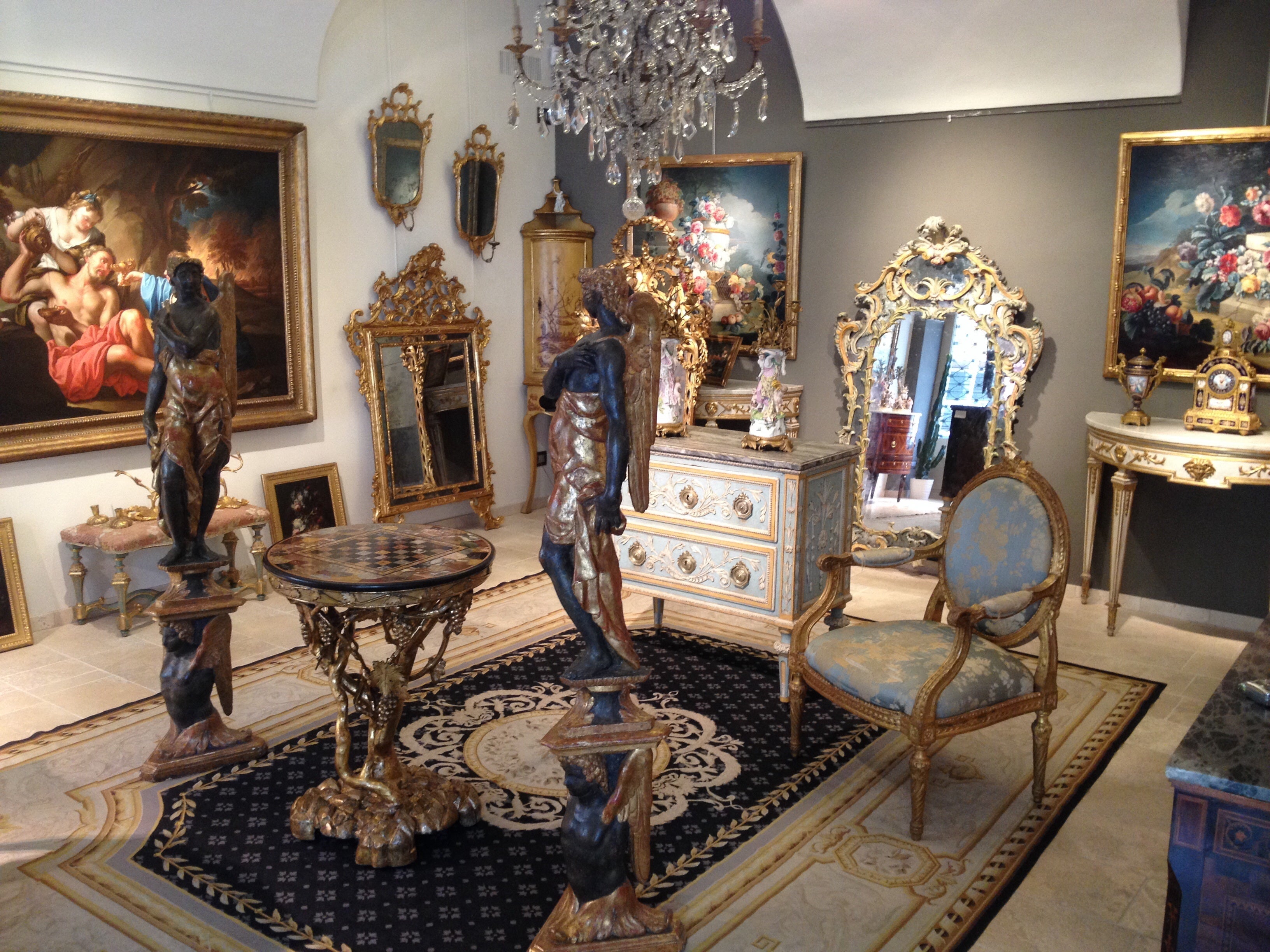
About the Seller
5.0
Vetted Professional Seller
Every seller passes strict standards for authenticity and reliability
Established in 1980
1stDibs seller since 2019
56 sales on 1stDibs
Typical response time: <1 hour
- ShippingRetrieving quote...Shipping from: Italy
- Return Policy
Authenticity Guarantee
In the unlikely event there’s an issue with an item’s authenticity, contact us within 1 year for a full refund. DetailsMoney-Back Guarantee
If your item is not as described, is damaged in transit, or does not arrive, contact us within 7 days for a full refund. Details24-Hour Cancellation
You have a 24-hour grace period in which to reconsider your purchase, with no questions asked.Vetted Professional Sellers
Our world-class sellers must adhere to strict standards for service and quality, maintaining the integrity of our listings.Price-Match Guarantee
If you find that a seller listed the same item for a lower price elsewhere, we’ll match it.Trusted Global Delivery
Our best-in-class carrier network provides specialized shipping options worldwide, including custom delivery.More From This Seller
View All18th Century, Painting Architectural Capriccio, att. to Isaac De Moucheron
Located in IT
18th Century, Painting with Architectural Capriccio with figures, attributed to Isaac De Moucheron
Measures: canvas cm H 108 x L 152; with frame cm H 132 x L 176 x 8
The painting i...
Category
Antique 18th Century Dutch Baroque Paintings
Materials
Canvas
Alberto Carlieri, Painting with Architectural Capriccio
By Alberto Carlieri
Located in IT
Alberto Carlieri (Rome 1672-1720)
"Architectural capriccio with the preaching of Saint Paul in the Areopagus of Athens"
Oil on canvas, measures with...
Category
Antique Late 17th Century European Baroque Paintings
Materials
Canvas
18th century, Couple of Italian Paintings Capriccio with Mythological Scenes
Located in IT
Couple of architectural capriccio with mythological scenes, oil on canvas, painter from Bologna active in the 18th century
The two large and valuable pantings depict two architectur...
Category
Antique Early 18th Century Italian Baroque Paintings
Materials
Canvas
19th Century, Oil on Canvas, Italian View of the Forum Boario of Rome
Located in IT
19th century, oil on canvas, Italian View of the forum Boario of Rome
The fine painting represents the Piazza della Bocca della Verità, located in the Ripa district, in the area of the Foro Boario, the oldest market in Rome (Italy). On the right is described the Roman Temple of about 100 B.C. wrongly called of Vesta, circular Corinthian monopter with cell of white marble ashlar and twenty fluted columns. From the 12th century it was reused as a church dedicated to Santo Stefano delle carrozze, then, in the 18th century, in Santa Maria del Sole. On the right you can see the fountain called "dei tritoni" which was built in 1717 on a design by architect Carlo Bizzaccheri. The fountain has a star-shaped bathtub, in honour of the commissioner, the Pope Clement XI...
Category
Antique Early 19th Century Italian Neoclassical Paintings
Materials
Canvas
Italian Painting Architectural Capriccio with Caio Cestio Pyramid after Panini
Located in IT
19th century, Italian Painting Architectural Capriccio with the Pyramid of Caio Cestio, Roman painter, after Giovanni Paolo Panini, unsigned.
Dimensions: cm H 48 x W 63.5, frame H 6...
Category
Antique 19th Century Italian Rococo Paintings
Materials
Wood
Couple of Italian Paintings Depicting Capricci, Francesco Aviani ‘1662-1715’
Located in IT
Francesco Aviani (Italy - Venice, 25-11-1662 / 1715) att.
Couple of paintings depicting Capricci
Oil on canvas, 135 x 183 cm, without frame
The two large and fine paintings depict two illusionistic architectural renderings, with views of colonnades and arched buildings, animated by figures. The compositions are characterized by the harmony with which the painter introduces the sumptuous architectural monuments, the mirrors of water, the buildings in the distance and the views of the landscape. Dominates with a color on the tones of brown and ochre that stands out on the blue sky, marked by some cloud of steam. The insertion of the figures to enliven the architectural views also balances with the set.
The Capriccio, an artistic genre that has made its way into Italian painting since the 17th Century, is characterized by the representation of fantastic architectures or prospective inventions, sometimes combined with elements drawn freely from reality. The two paintings are an example of this type and they are a very interesting and Fine artwork.
The remarkable pictorial quality emerges both from the composition of the ensemble and from the way in which the artist describes the views with great attention to detail, highlights and refined, perfectly realistic, chiaroscuro.
The same must be recognized for the figures: these are described with a wise brushstroke, quick and quick touches give the dynamism of the moment that is captured, as if time had stopped to show and narrate what is happening.
The painting on the right represents a large Baroque building in stone and paved with marbles, two floors, with moving façade, large columns with corinthian columns, a large portal with a staircase with large footsteps, a balustrade with string, from which some figures appear, and two equestrian monuments in bronze. The sumptuous building overlooks a large POOL of water, with a gushing fountain, around which some characters sit. In the second floor is described a white palace from which rises a tower crowned by a structure with wrought iron loggia. In addition there is a bridge and some architectural ruins behind which some mountainous reliefs fade towards the horizon.
On the staircase is described a particular scene. The people seem to be part of a very precise story. A woman, in the shadow of a parasol supported by a servant, would seem to drive out of the palace a man, who, taken under his arm by two maidens with a determined attitude, is led to a boat.
The scene could be identified with the biblical episode of the parable of the prodigal son (Luke 15,11-32), at the moment when the prodigal son is robbed and driven away by the harlots.
The episode tells of a man with two children. The youngest said to his father: “Father, give me the part of my inheritance”. And the father divided the substances. After not many days, the youngest son, collected his things, left for a far country and there he lost his substances with prostitutes and living as a debaucher. When he had spent everything, there came a great famine in that country and he began to find himself in need. Reduced to hunger, he was forced to be a pig herder to survive. He therefore meditated in his heart to go to his father and ask for his forgiveness and to be welcomed anew, even as a servant.
While still on the road, however, the father saw him and ran towards him, receiving him with open arms. He then ordered his servants to prepare a great feast for the occasion, killing for the purpose the "fatty calf". The firstborn did not understand why his brother was given such treatment, and reminded the parent that he, who had always obeyed him, had never received a single kid to celebrate with his friends. The father answered him: «Son, you are always with me and everything that is mine is yours; but it was necessary to celebrate and rejoice, because this brother of yours was dead and came back to life, was lost and was found».
The parable of the prodigal son was often portrayed in painting and the scene he finds most is certainly that of returning home in his father’s arms. Among the many is a canvas by the famous painter Giovanni Paolo Pannini (or Panini) (Italy – Piacenza, 1691– Rome, 1765) kept at the Hallsborough Gallery in London.
Rather rare, however, is the scene of the prodigal son driven and robbed by harlots. There is an engraving by Hans Collaert II (1561-1620) in which this moment is described in the background compared to the moment, narratively later, in which he is penitent among the pigs.
The second painting, certainly pendant of the first, represents a similar palace, with some characters overlooking the balustrade marcapiano and other figures around the large bathtub quadrilobata. In the foreground is described a monument with two large stone sculptures. In the distance some architectural elements and, beyond, the mountains are lost on the horizon.
The studies related to the numerous painters of architectural views and caprices, active in Italy, and the archival documents found, which could better clarify commissions, biographies and certain works, are scarce and sporadic. Therefore there are still many difficulties in reconstructing a catalogue of autograph works for each author. Through paintings in private collections, in museums and paintings passed on the antique market it is however possible to advance some attributions in order to better delineate the various artistic figures.
The style of the works studied here leads to a dating that runs between the 17th and 18th Centuries, with obvious influences dictated by the perspectives of the brothers Galli Bibiena. The analysis of the architectures and the chromatic palette suggests that we are in the presence of a northern Italian and Venetian author. Observing the decorations and the volutes, the brightness and the perspective disposition in fact, we find several analogies with those used by the Vicenza painter Francesco Aviani, excellent in pictorial perspective and architectural views.
The biographical profile of Francesco Aviani (Italy - Vicenza, 1662-1715) was essentially traced in 1956 by Andreina Ballarin, then re-visited by Federica Spadotto in 2014 and Giancarlo Sestieri in 2015. Certain documents about his life are scarce, as are the documented works.
He was born in Venice, probably on 25 November 1662, to Bernardo and a Magdalene whose surname is unknown, and was baptized on 3 December 1662. Between 1701 and 1703 he worked, together with his brother MarCo, sculptor, for the fresco decoration (now illegible) of the church villa in Soella (Vicenza). On October 16, 1703 he married Isabella Carcano. On March 26, 1715 he made a will and died on April 3 of the same year, in Vicenza.
The frescoes in the refectory of the sanctuary of Monte Berico in Vicenza are considered authentic works by Aviani, probably made in 1708; the paintings preserved in the Civic Museum of Vicenza: “Landscape with Lazzaro and the rich Epulone”; “Christ among the doctors”; “The miraculous fishing”, works not datable but with attribution corroborated by style. In addition, the frescoes in the east and west corridors of the Villa La Rotonda, near Vicenza; the fresco in the apse basin of the chapel of the church S. Croce, Vicenza, now destroyed; the frescoes of the central hall of Villa Camerini a Montruglio (1714) and a painting of a “Porto Regio”, of which we have a print engraved by Dall'Acqua.
From his works emerges the artistic background that animated the Venetian culture in the early eighteenth century. The scenic grandeur with which Aviani treats the architecture also suggests a stay in Emilia of the painter, in which he could have come into contact with the environment of the Bibiena. These contacts would be confirmed by the press of Cristoforo Dall'Acqua (Vicenza 1734-1787), “Il porto regio”, after a painting of Aviani. The press was part of a group of engravings, representing royal buildings, reproducing paintings of the Bibiena. In the eyes of Dall’Acqua, therefore, Aviani’s work was not foreign among those of the Emilians.
Inside the sumptuous architectural whims, Aviani often depicts biblical scenes, in which the characters share the space and the narrative rhythm, along with figures drawn from everyday scenes, memories of the Veronese and Bassano heritage. Also in the works covered by this study the author does not seem to want to give up a biblical subject, though the purpose of the paintings appears to be clearly a staging scenography-architectural within which the characters are relegated to the role of extras.
From the examination of the architectural Capriccio gathered under the name of Aviani then emerge common elements. The comparison between these works and the works in question highlights the proximity of the compositions. The imposing and scenic architectures are in fact equally characterized by the perspective-scenographic ability diffused in emilian “quadraturisti” and in Bibiena work. In fact, you can see the spectacular slender architecture in the lower part, the loggias that create chiaroscuro games with arches and binate columns placed on massive bases and overhung by projecting cornices.
Significant also the comparison with two paintings with architectural whims in a night vision attributed to Francesco Aviani.
In Aviani’s works it is possible to find a certain knowledge of the Roman Codazzi paint nd its early development of the eighteenth century, developed with the Locatelli, the Pannini and the less known Domenico Roberti. To Roberti have been recently attributed two works that have some compositional affinity with the canvases in question. The same can be done for a work on the antique market, attributed to Pietro Francesco...
Category
Antique Late 17th Century Italian Baroque Paintings
Materials
Canvas
You May Also Like
Italian Early 18th Century Roman Oil on Canvas, of an Architectural Theme
Located in West Palm Beach, FL
A very attractive Italian early 18th Century Roman oil on canvas, of an architectural theme. The painting is of a central round pavilion amidst ruins accente...
Category
Antique 18th Century Italian Paintings
Materials
Canvas, Giltwood
18th Century Oil on Canvas Italian Capriccio Painting of Architectural Ruins
Located in Los Angeles, CA
This Italian capriccio oil painting offers a vivid portrayal of Roman architectural splendor in ruins, crafted with skillful detail and a sweeping, atmospheric perspective. Set withi...
Category
Antique 18th Century and Earlier Italian George II Paintings
Materials
Canvas
Italianate Capriccio Oil of Figures in Classical Ruins
Located in Queens, NY
Italianate style (19th Century) capriccio on an architectural oil on canvas painting with figures among classical ruins in an ebonized frame.
Category
Antique 19th Century Renaissance Paintings
Materials
Paint
18th Century Oil on Canvas Italian Architectural Capriccio Landscape Painting
Located in Vicoforte, Piedmont
Great 18th-century architectural capriccio with figures. Oil on canvas painting depicts an evocative architectural capriccio with ruins, enlivened by elegant figures in oriental cost...
Category
Antique 1740s Italian Paintings
Materials
Canvas
Italian Painter of 1700 "Capriccio with classical ruins and figures"
Located in Cesena, FC
Painter of ruins xviii century:
"capriccio with classical ruins and four figures" , pendant with "capriccio with classical ruins and three figures"
Oil on canvas cm 140 x 95
The ...
Category
Antique 1730s Italian Paintings
Materials
Canvas
Italian 19th Century Grand Tour Capriccio in the Manner of Panini
By Giovanni Paolo Panini
Located in Montreal, QC
Italian 19th century Grand Tour oil painting on canvas in the manner of Giovanni Panini depicting a landscape with roman ruins, framed in a shaped carv...
Category
Antique 1880s Italian Neoclassical Paintings
Materials
Canvas
More Ways To Browse
Gary Janis
Grisaille Neoclassical
Hawaiian Glass
Jean Baptiste Pillement
Jesus And Mary Painting
John The Baptist Head
Lee Reynolds On Sale
Maria Astadjov
Miniature Brass Frames
Museum Gilt Frame
Myanmar Paintings
Oil Painting Serbia
Pagoda Painting
Painting Wall Lamp
Paintings Of Clipper Ships
Paul Delaroche
Piero Della Francesca
Prize Cow
